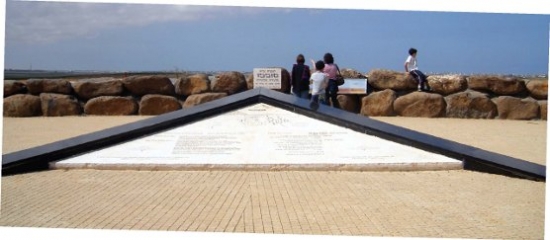
The Black Arrow vantage point over Gaza.
Perched on a hill overlooking a portion of the patrol road and electronic fence surrounding the Gaza Strip - and affording a view over the Palestinian neighborhoods and Mediterranean beyond - the Western Negev Black Arrows memorial site is overwhelming.
The sheer size of the site and the number of soldiers and civilians memorialized in the groups of enormous white rocks placed around the site forcefully brings home some of the heavy Israeli losses incurred in military and terrorist action over a three year period in the 1950s.
The Black Arrow Association was founded by a group of veteran paratroopers who served during that dramatic and painful period of reprisal actions. The not-for-profit Black Arrow Association set out to create a military heritage site to preserve the memory of comrades killed in battle, many of whom having died a short distance from the site that has developed into a most powerful salute to their bravery.
The site is dedicated to the military heritage of the paratroopers during 'the period of reprisals.' From the end of the 1948 War of Independence to the outbreak of the Sinai campaign in 1956 hundreds of Israelis were killed and more than one thousand wounded in terrorist attacks inside the State of Israel.
Since the beginning of the 1950s, groups of soldiers from neighboring countries and armed Arab marauders known as 'fedayoun,' spawned fear, death and destruction, particularly in the border villages some of which were settled by new immigrants from North Africa, groups of Holocaust survivors as well as members of Zionist youth movements.
One of the Israelis murdered was a young kibbutz member from that part of the Negev. In April of 1956 kibbutz Nir Am member Roi Rutenberg was murdered in an ambush at his home, a short distance from the present day Black Arrow site. On a small hill overlooking the Western Negev kibbutz, a black horse and rider stand out against the skyline in memory of Rutenberg.
Reprisal actions were initiated by the Israel Defense Forces. In the three years prior to the Sinai campaign, Israeli forces carried out 70 forages into Egyptian-held Gaza and the then Jordanian-held West Bank in retaliation for acts of infiltration, theft and murder carried out in Israel by enemy soldiers and gangs of fedayoun.
Unit 101 was created in the summer of 1953 and those who served in the unit were revered. One of the most famous of the l01s was former Prime Minister of Israel, Ariel Sharon.
On each of the large rocks spread out over the extensive Black Arrow site, a plaque gives details of each of those raids. Audio information stations can be found at vantage points throughout the site, the in-depth explanations provided both in Hebrew and English.
For the first five months after their inception the 101s operated alone and were then merged with paratrooper battalion 890, and carried out the remaining actions as one combined unit. In 1956 they were joined by the advanced training battalion of the NAHAL – an acronym in Hebrew for 'combat pioneer youth.'
"These paratrooper battalions restored self-respect and self-confidence to the State of Israel and to the IDF in particular, and the commanders battle cry of "follow me" became a national motto," explains Moti Blustein, a seasoned guide and veteran member of nearby Kibbutz Niram.
Blustein, a salt of the earth Israeli with an impressive handlebar moustache, proves to be a walking, talking almanac when discussing the Black Arrow site and surrounding region, even though he spends a great deal of his time guiding Israelis in far away places the likes of Morocco, Spain, China and countries in the Former Soviet Union.
Moti takes us to the main section of the Black Arrow site. Over a low wall one receives a breathtaking vista of the central and northern neighborhoods of Gaza, and in the not so far distance, the sun shines on the Mediterranean.
Pointing out various large buildings in the near distance, Moti explains in detail what it is that one can see so clearly. Not only see, but also hear. Gaza is close enough for one to hear calls for prayer coming out of the Palestinian mosques, to hear car horns beeping in the busy streets of the commercial areas – to actually feel Gaza.
"That building over there," says Moti pointing to a grayish-looking large complex, "is Shifa Hospital where the leadership of Hamas were hiding in the cellars during Operation Cast Lead. Everybody knew they were there but because it is a hospital it was left untouched."
As Moti points out a few other much heard about Palestinian neighborhoods and explains what it meant for the local residents to live under constant threat from the Kassam rockets fired from such close quarters, an Israeli patrol jeep drives slowly along the sophisticated electronic fence.
The jeep kicks up huge clouds of dust and Gaza disappears – temporarily.
"There were days when going to visit Palestinians we befriended in Gaza was so natural that we didn't discuss it in particular," says the white-haired kibbutz member, wistfully looking across the short distance between the Black Arrow site and the Palestinian homes about a kilometer away.
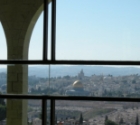 The Morman University Sunday Concert, with ESRA
The Morman University Sunday Concert, with ESRA 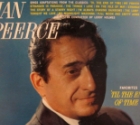 Congratulations to ESRA Rehovot on its 10th
Congratulations to ESRA Rehovot on its 10th 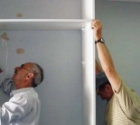 THANK YOU!
THANK YOU! A new website in English - on Volunteering - Launched in Israel
A new website in English - on Volunteering - Launched in Israel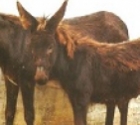 Help Needed for Abused Horses and Donkeys
Help Needed for Abused Horses and Donkeys Heather's Heseg
Heather's Heseg Lydia Aisenberg
Lydia Aisenberg